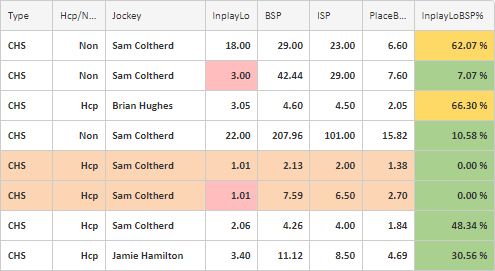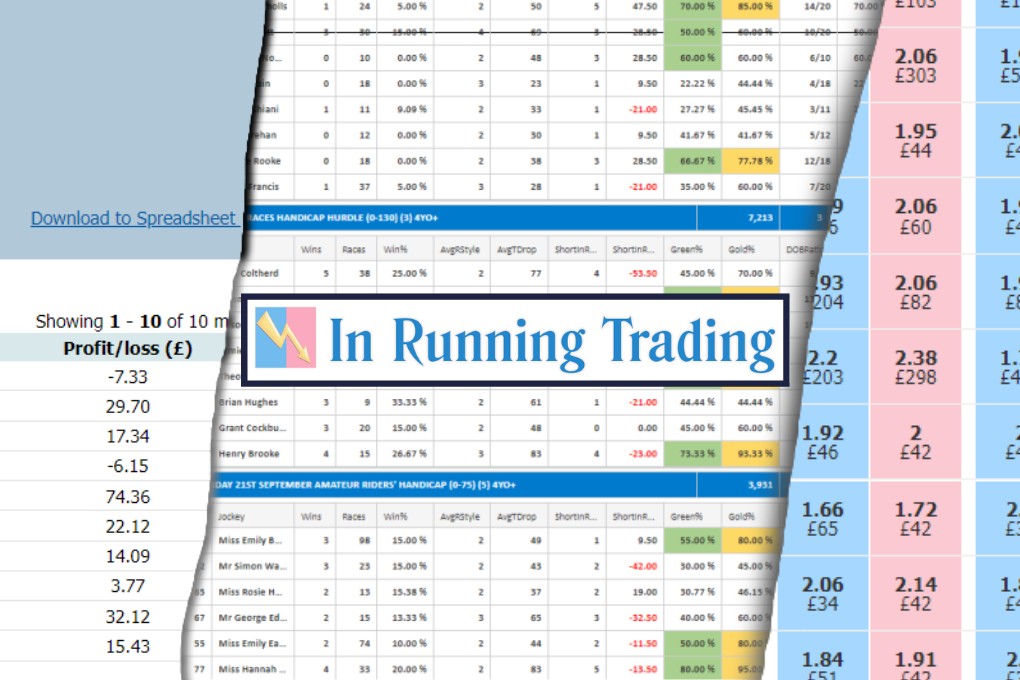If you’re on the hunt for an in-play horse racing advantage it’s worth reading this in-running trading tool review fully…
Pundits and the media come up with all kinds of weird and wacky justifications for horse racing performances. But in reality, there are only a handful of sources that are truly useful when it comes to in-running value – historical betting data being the main one.
After all, it’s a collection of opinions that other people were willing to put their own money on.
What is the In-Running Trading Tool?
As the name suggests; the in-running trading tool is a software product that helps you identify trading patterns and trends for in-running trading.
Building custom applications that harvest data points from multiple sources isn’t an easy task.
Over the years I’ve messed around with various automation projects, and they all taught me one thing – leave it to the software nerds!
This particular tool has been developed with a focus on the actual data and information, rather than a shiny user interface with lots of bells and whistles. Hold your initial judgments for a second as we take a look at…
How It Works:
Each day, the tool scans the up-and-coming horse racing fixtures to see which horses are running and where. It then collects the relevant historical data for each horse and populates a large range of information on each of them, in line with the day ahead.
The information is presented inside the software app with a range of filters, statistics, and prices for the horses that have previously been traded.
If you’re interested in finding hold-up performers, strong travellers, or front-runners it stands out in the data…
It won’t tell you how many lengths per second each horse was travelling at, but it’s a great way to highlight potential opportunities that the general public is not aware of. As the saying goes; numbers don’t lie.
For example, in the image above, take a look at Maid O’Malley.
Out of 19 races this horse’s price has dropped more than half on 12 occasions (63.16%). The horse’s average running style is 2 meaning that although it’s often fairly prominent in the race, but it’s not a stand-out leader. The green and gold percentages indicate just how far the horse’s price routinely drops in running. The in-running trading tool has shown us that this horse is potentially a good choice for a dobbing strategy.
There’s a free trial here if you want to try the tool by clicking here.
Main Features:
The best bits (from our perspective) are the ability to manipulate and filter the data. Finding a stand-out opportunity fast is helpful, but comparing and analyzing it’s competition within the race is even more important.
Identifying profitable and low-risk trading options, within a race, before it even starts is ideal. If the race kicks off and a jockey is forcing a different running style, there’s time to exit the position and limit risk.
Alternatively, if everything is going to plan and you intend to take an over-inflated price on a hold-up performer, that’s great.
No doubt there are further ways to make use of the data, these are just a few ideas…

You can drill down on each historic run for a horse too (see above). The historical in-play lows, BSP (Betfair Starting Price) and price drop percentages are all available. You can even set up custom filters for the percentages.
The software also includes an in-running trading calculator and double or bust tab.
How Much Does it Cost?
At the time of review, the in-running trading tool costs £79 for a full 12 months of access. That works out at £6.58 per month, which is extremely reasonable when you consider the amount of work that has gone into it.
There is a 7 day free trial if you go via this link here.
There aren’t alternative payment plans right now although we hope they add some soon!
Ideal In-Running Trading Tool Strategies:
If you’ve got other creative ways to use this in-running tool then please leave them in the comment section below, here are a few to review that we might suggest:
- Dobbing – the practice of backing a horse that is likely to half in price. A kind of bet on their performance, either doubling your stake or going bust.
- Back to Lay – betting on a horse to win to lay that same horse back to the marketplace once it has contracted in price. Usually, this is done on front-running horses that travel well. The advantage is that the wider public betting in-running may not know about the horse’s running style.
- Lay to Back – the complete opposite of the previous strategy. Typically used on very short-priced favourites that give the appearance they are not trying whilst running. Again, it’s deceptive to those who have not done proper research. Routinely it happens, but beware of laying larger prices in the anticipation of a drift.
- Hold-Up Surges – identifying horses that run a race in the rear, potentially looking out of ability, that then lunge forward in the final straight. Backing for a small stake on a very large price when the marketplace has written of a horse’s chances can be high reward and low risk.
Thanks for reading our review, hopefully, that gives you a positive start!




3 thoughts on “In Running Trading Tool Review 2024: Horse Racing Advantage?”
Hi, I’ve been trying to get in touch via email and messenger regarding the pre off racing course I’ve just bought. Cannot log in or get the recovery link through. Please check the inboxes
Hey! we responded to your email this morning. Will re-send it again now, maybe check all folders. Thanks.
I am interested in horse race dobbing
SusnvGoldsmith